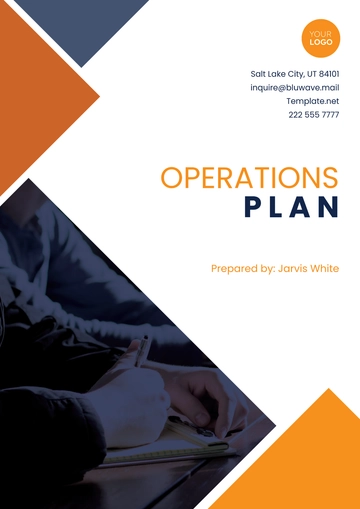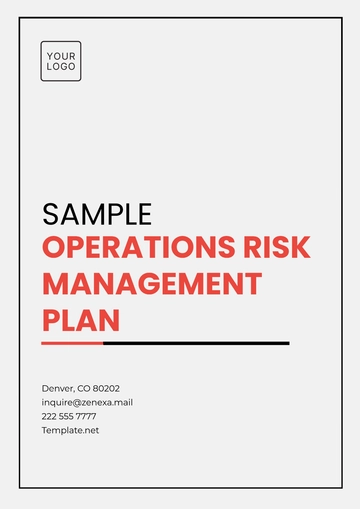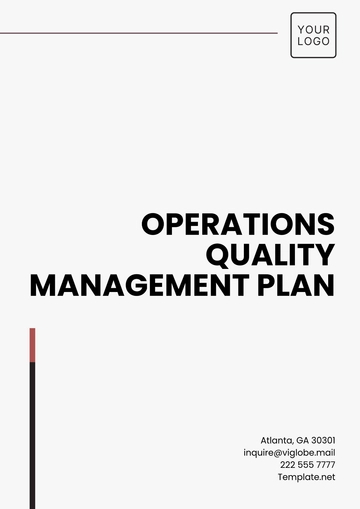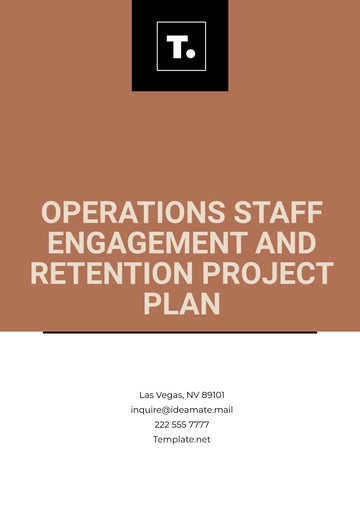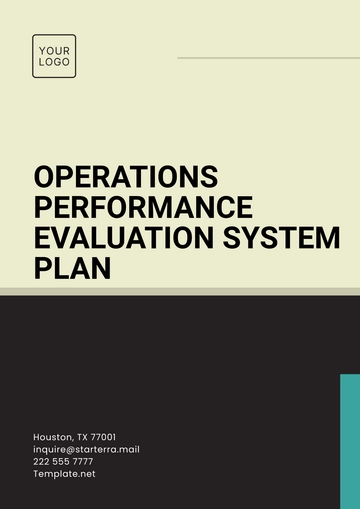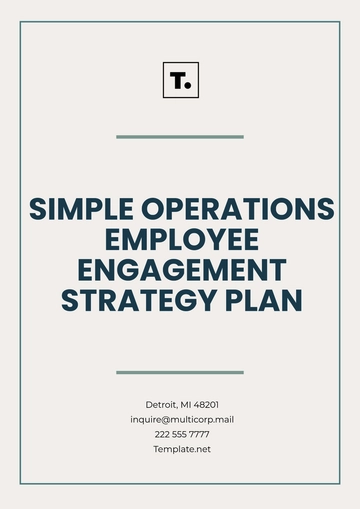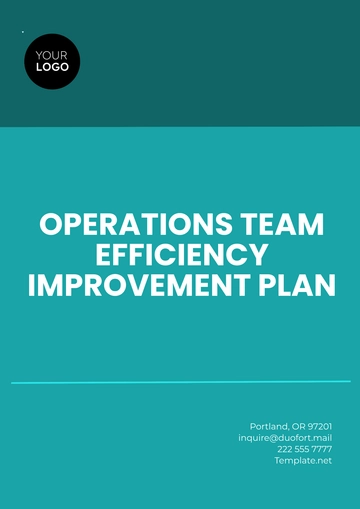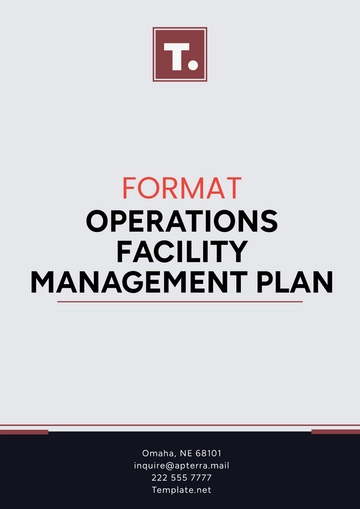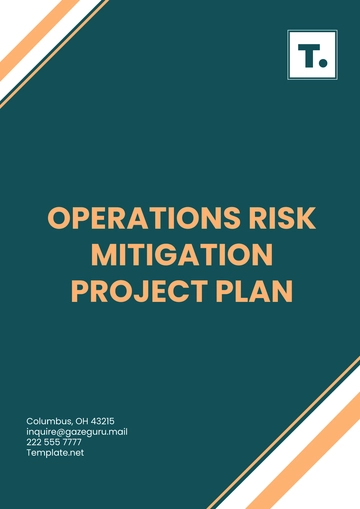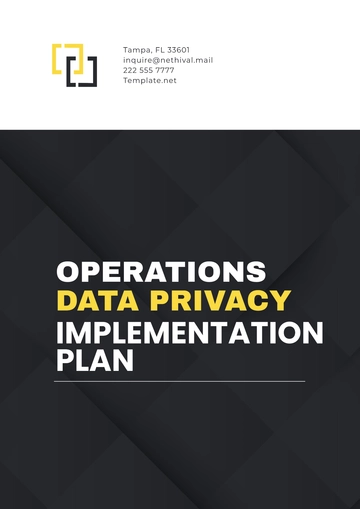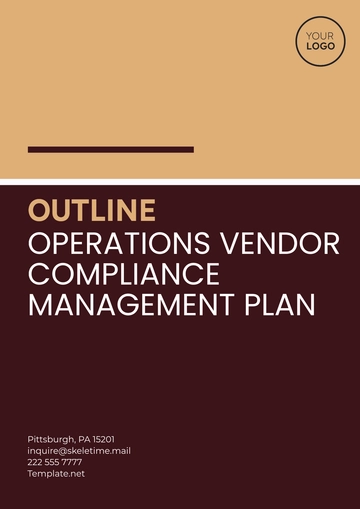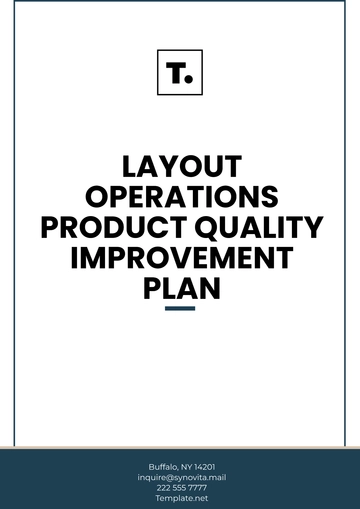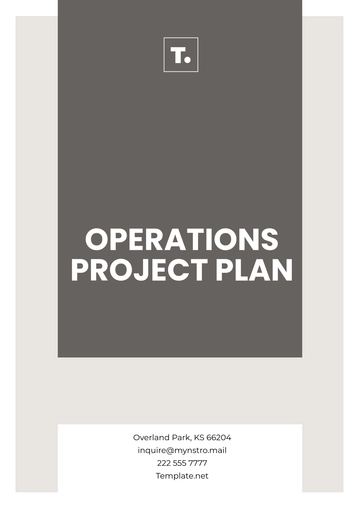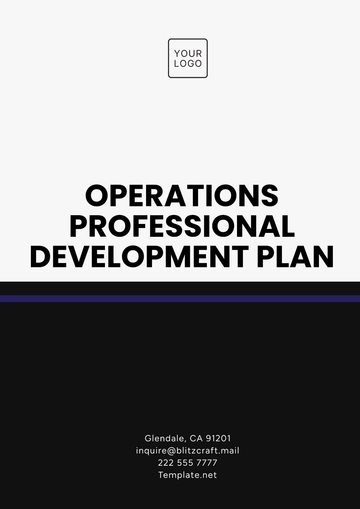Free Defense Military Operational Plan
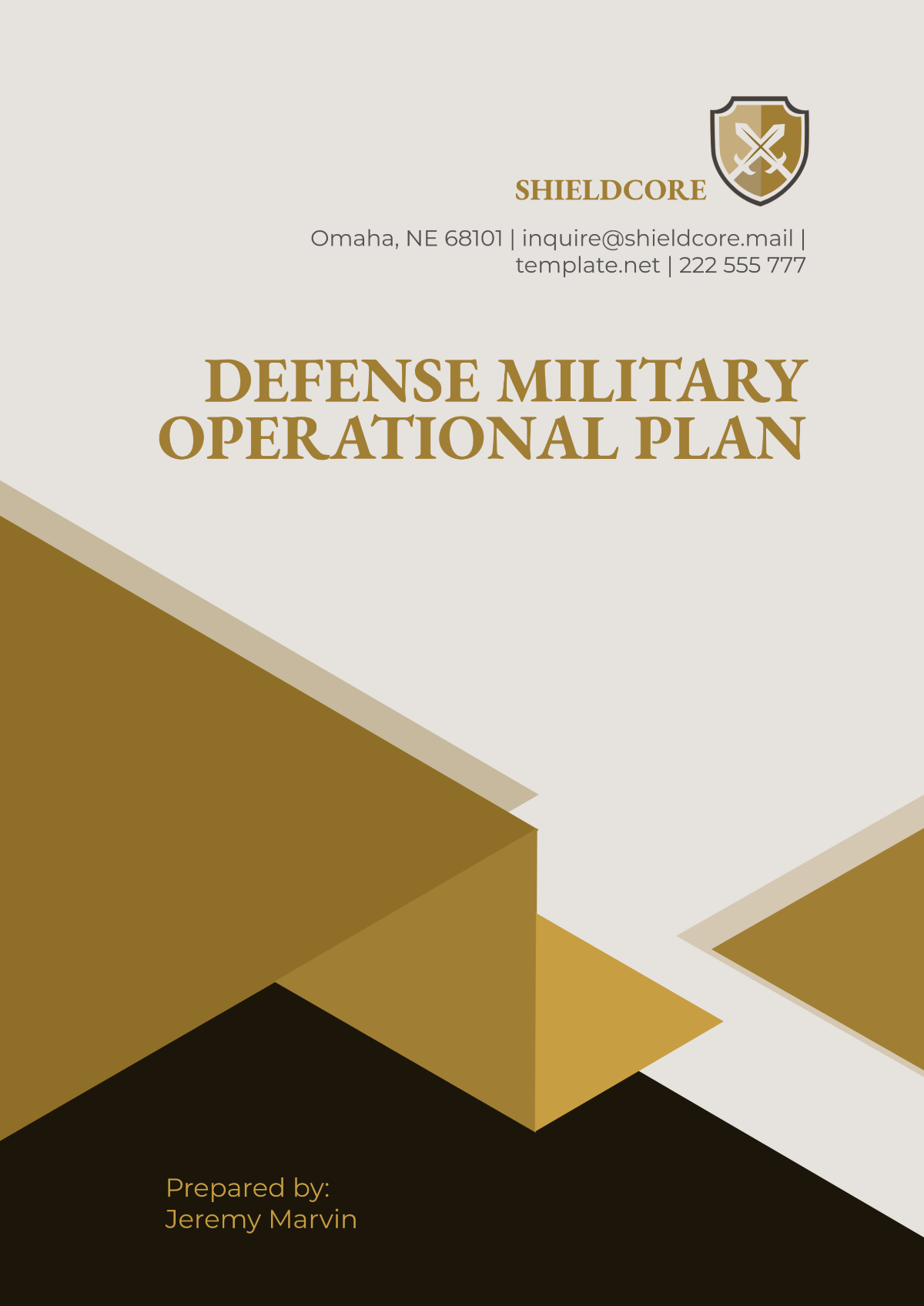
I. Introduction
A. Purpose of the Plan
[Your Company Name]'s Defense Military Operational Plan (OPLAN) outlines the strategy and execution framework for Operation Secure Shield, aimed at addressing the evolving regional threats in the Eastern Mediterranean. The plan ensures operational readiness and aligns all efforts with national defense goals. The primary objective is to neutralize enemy threats while safeguarding allied and civilian interests.
B. Scope and Applicability
The scope of this plan covers all combat and non-combat operations within the defined area of responsibility (AOR) of the Eastern Mediterranean. It is applicable to all military units and supporting agencies engaged in the operation. It includes all phases from preparation to withdrawal and post-operation analysis.
C. References and Supporting Documents
This plan incorporates references from the latest Joint Doctrine and national defense strategy documents. Key sources include the 2024 National Defense Strategy (NDS) and Joint Publication 3-0 (Joint Operations). Additionally, local agreements with allied forces and UN directives are integrated into the operation's framework.
D. Assumptions
It is assumed that international alliances will remain intact throughout the operation. Enemy forces are expected to operate under asymmetric warfare tactics, utilizing irregular and cyber methods. Weather conditions will be stable for the duration of the initial phase, with only limited seasonal disruptions anticipated.
II. Situation Analysis
A. Strategic Context
Political and Geopolitical Environment
The region is experiencing heightened tension due to territorial disputes over maritime resources. Diplomatic channels remain open, but military escalation is possible, particularly with the actions of non-state actors. There is an ongoing international effort to maintain peace through peacekeeping operations led by NATO and the UN.
Enemy Forces and Capabilities
The enemy consists of both state and non-state actors, including irregular militias and state-sponsored paramilitaries. Enemy forces are estimated to have a high degree of proficiency in asymmetric warfare, using guerilla tactics, cyber attacks, and precision strikes. Their capabilities include anti-ship missiles, drones, and cyber infiltration tools.
Friendly Forces and Capabilities
Our forces include two mechanized infantry brigades, one naval task force, and an air support wing with advanced fighter jets and surveillance assets. Allied forces from NATO will provide air defense and intelligence-sharing capabilities. Combined, the forces have the operational capacity to outmatch enemy forces in conventional warfare but face challenges in cyber and unconventional threats.
B. Operational Environment
Terrain and Weather
The area of operations includes mountainous terrain, coastal regions, and scattered islands. The terrain is challenging for ground operations but ideal for naval and air-based operations. Weather forecasts predict mild conditions, with limited rain expected during the first phase but no major storms.
Civil Considerations
The population is diverse, with a mix of local civilians and expatriates. Infrastructure is generally underdeveloped in rural areas but more modern in urban centers, particularly along the coast. Civil unrest is a possibility, particularly in urban centers with significant refugee populations.
C. Threat Assessment
Enemy Courses of Action (COA)
The enemy is likely to initiate irregular attacks on critical infrastructure and attempt cyber sabotage to disrupt command and control. They may also attempt to provoke diplomatic incidents by escalating violence near key international shipping lanes.
Threat Prioritization
The primary threat is the use of precision-guided munitions (PGMs) against high-value targets, including naval vessels and command centers. Cyber threats aimed at disrupting communications and intelligence-sharing are also high-priority concerns.
III. Mission Statement
A. Objective
The objective of Operation Secure Shield is to neutralize hostile threats in the Eastern Mediterranean and secure key strategic assets, ensuring the safety of allied forces and regional stability. This will involve both direct action and strategic deterrence through intelligence operations.
B. End-State Goals
The operation will aim for the complete dismantling of enemy combat capabilities, ensuring no further territorial incursions. Additionally, we aim to foster long-term peace by bolstering the defense capabilities of regional allies. The end-state will be the restoration of maritime security and the establishment of a robust peacekeeping presence.
C. Key Tasks
Key tasks include the seizure of enemy-controlled islands, establishment of defensive positions in key areas, and the protection of shipping lanes. The operation will also focus on ensuring the continuity of vital supply lines, particularly for fuel and food supplies. A final task will be the smooth handover of operational control to local security forces, post-mission.
IV. Concept of Operations (CONOPS)
A. Commander's Intent
The Commander’s intent is to swiftly neutralize enemy combat units while minimizing collateral damage. The operation will use a combined arms approach, integrating air, land, and sea forces. Successful completion of the mission will restore stability and protect international trade routes in the region.
B. Operational Phases
Phase I: Preparation and Deployment
Deployment of key forces, including amphibious landing units and air surveillance assets.
Establishment of forward command posts in designated safe zones.
Initiation of intelligence gathering through local networks and satellite assets.
Phase II: Initial Engagement
Conducting targeted airstrikes on key enemy infrastructure and weapons caches.
Commence ground operations to secure critical areas.
Coordination with allied forces for synchronized actions.
Phase III: Sustained Operations
Full-scale combat operations to neutralize remaining enemy forces.
Continuous air and naval support for ground units.
Increased intelligence operations to track remaining threats.
Phase IV: Transition and Withdrawal
Secure key positions for handover to local forces.
Begin phased withdrawal of allied forces.
Final debrief and after-action review (AAR) to assess mission success and identify lessons learned.
C. Key Milestones and Decision Points
D-Day (Day 1): Initial deployment and force readiness achieved.
Phase II Completion (Day 10): Completion of major engagement with enemy forces.
Phase IV Completion (Day 30): Full withdrawal and operation handover.
D. Main Effort and Supporting Efforts
Main Effort: Securing strategic coastal positions and ensuring maritime control.
Supporting Efforts: Cyber operations to disable enemy communications and intelligence sharing.
V. Task Organization
A. Command and Control (C2) Structure
The command and control structure will be led by General [Your Name], who will oversee all operational components within the theater. The Joint Task Force (JTF) will manage coordination between air, land, and naval forces, with each branch reporting directly to the JTF headquarters. Subordinate commands will include Army, Navy, and Air Force components, with specialized units such as Special Operations Forces and Cyber Command providing targeted support.
B. Assigned Units and Roles
The operational structure is as follows: the Army will lead ground operations, the Navy will maintain maritime control, and the Air Force will provide air superiority and close air support. The Army’s 1st Armored Brigade Combat Team (ABCT) will be tasked with securing key terrain and critical infrastructure. The Navy’s Task Force 22 will be responsible for establishing a naval blockade and ensuring freedom of movement for allied vessels.
C. Task Assignments for Supporting Forces
Special Forces will be assigned high-priority direct-action missions, such as capturing key enemy leaders and sabotaging enemy logistics hubs. Cyber Command will provide critical support by securing all communication channels and disabling enemy cyber capabilities. Intelligence units will assist in identifying high-value targets and maintaining situational awareness through surveillance and reconnaissance operations.
VI. Execution Plan
A. Operational Timeline
Phase | Action | Duration | Milestone |
|---|---|---|---|
I | Deployment of forces and preparation | 3 Days | Command posts established, forces in position |
II | Initial combat engagement and seizure of key locations | 7 Days | Primary enemy infrastructure neutralized |
III | Continued operations, mopping up and securing the area | 15 Days | Major enemy units eliminated, operational security established |
IV | Transition to post-conflict operations and withdrawal | 5 Days | Hand over to local security forces, mission complete |
B. Operational Objectives by Phase
Phase I | The primary objective is to establish operational control over key terrain and set up forward command posts. The forces will focus on securing vital infrastructure and preparing for large-scale engagement. Communications and logistics hubs will be set up to support continued operations. |
Phase II | Combat operations will focus on neutralizing enemy strongholds and seizing critical positions, including coastal and urban areas. The Navy and Air Force will coordinate to establish air superiority and maritime security. Intelligence teams will monitor enemy movements to ensure quick decision-making during engagements. |
Phase III | This phase will involve clearing out remaining enemy forces, with continued air and ground support. Special Forces will conduct targeted operations to dismantle enemy leadership and prevent any counteroffensive. Extensive reconnaissance will provide real-time updates to ensure a successful consolidation of control. |
Phase IV | In the final phase, forces will transition control to local allied forces, ensuring the security of critical infrastructure before withdrawal. Post-operation assessments and debriefs will provide insights for future operations. A peacekeeping presence will be established to oversee the stabilization efforts until local forces can fully take charge. |
C. Contingency Plans
In case of significant enemy reinforcements, the backup plan will involve a rapid reinforcement strategy from adjacent theaters, with an emphasis on airlift and sealift capabilities. If the situation demands a more complex operational environment, additional forces will be moved to expand the operational footprint and provide further security. For cyberattack disruptions, the Cyber Command will be on standby to defend against and mitigate any communications or data breaches.
VII. Logistics and Sustainment
A. Supply Chain Management
The supply chain will ensure that critical resources such as fuel, ammunition, medical supplies, and food reach the frontline units without delay. Airlifts and naval transport will be used to resupply remote units, with an emphasis on maintaining operational readiness at all times. Local partnerships will be utilized where possible to ensure the availability of basic resources like water and construction materials.
B. Transportation and Movement
The movement of troops and equipment will rely on a combination of air, sea, and ground transport to ensure flexibility and rapid response. Convoys will move through secured corridors, with military police providing security for high-priority transport routes. Heavy equipment will be deployed via amphibious landings and airlift to ensure timely access to key strategic locations.
C. Sustainment of Forces in Theater
Logistics teams will manage the ongoing sustainment of forces in theater, including the maintenance of vehicles, weapons, and equipment. A field hospital will be set up in a designated safe zone to support injured personnel. Rotations of support personnel and reinforcements will be planned to ensure operational continuity and prevent fatigue.
D. Critical Infrastructure Requirements
Key infrastructure such as communication hubs, supply depots, and transportation routes must be prioritized for protection. Satellite communications will be the primary means for coordinating operations, while backup systems will be in place in case of technological failure. Civilian engineers and military units will collaborate to rebuild damaged infrastructure and ensure long-term stability.
VIII. Force Protection
A. Personnel Security
Personnel security will be enhanced through a combination of force protection measures, including fortified perimeters and surveillance. A high level of security will be maintained for command posts, critical infrastructure, and personnel quarters. Special teams will be assigned to conduct regular security sweeps and ensure that no breaches occur.
B. Physical Security of Facilities and Assets
All critical facilities, such as weapon storage sites, communication hubs, and fuel depots, will be fortified and guarded. Access control measures will ensure that only authorized personnel can enter sensitive areas. Security personnel will conduct regular patrols and use surveillance systems to detect any intrusions or threats.
C. Counterintelligence and Cybersecurity Measures
Cybersecurity will be a top priority, with dedicated teams monitoring for any potential cyberattacks that could disrupt command and control. Counterintelligence operations will be carried out to prevent enemy infiltration within the ranks. Deceptive operations and misinformation campaigns will also be used to confuse enemy forces and reduce the risk of espionage.
D. Risk Mitigation Strategies
Risk mitigation will be achieved by diversifying routes for logistical convoys and maintaining constant communication with all units. The use of camouflage, decoys, and electronic countermeasures will help minimize exposure to enemy surveillance. Force protection measures will also include preparation for possible chemical, biological, radiological, and nuclear (CBRN) threats.
IX. Rules of Engagement (ROE)
A. Legal and Ethical Guidelines
The operation will adhere to international humanitarian law (IHL), with particular emphasis on minimizing civilian casualties and preserving the dignity of prisoners of war. All actions will be in accordance with the Geneva Conventions and other relevant treaties. Military personnel will receive briefings on their legal obligations under the ROE.
B. Escalation of Force Protocols
Force will only be used in accordance with the principle of proportionality, with escalating force steps taken in response to enemy actions. Non-lethal methods such as warning shots and dispersal tactics will be employed before resorting to lethal force. Commanders will retain the authority to adjust escalation protocols based on real-time threats.
C. Non-Combatant Considerations
Every effort will be made to avoid harm to non-combatants, with designated safe zones established for civilian refuge. Humanitarian organizations will be involved to assist in the provision of aid to displaced persons. Clear communication with the local population will be maintained to ensure they understand the risks and the protections available.
X. Communications Plan
A. Communication Channels and Networks
A multi-tiered communication system will be established, combining satellite communication (SATCOM), radio frequencies, and secure internet channels. Primary communication will occur through encrypted tactical communication devices, with secondary backups in place. Regular drills will ensure all personnel are familiar with communication protocols.
B. Secure Communications Protocols
All communication will be encrypted to prevent interception by enemy forces. Personnel will undergo security briefings on recognizing and avoiding communication security breaches. Cybersecurity experts will monitor for any potential hacking attempts aimed at disrupting command and control.
C. Interoperability with Allied Forces and Agencies
A standardization agreement will ensure that all allied forces can communicate effectively, even if using different systems. The use of common encryption and communication tools will ensure seamless coordination. Real-time intelligence and tactical updates will be shared with multinational partners to optimize operational success.
D. Contingency for Communication Failures
In the event of communication failure, backup methods such as couriers and pre-arranged signals will be utilized. Satellite phones and emergency radio systems will be distributed to key personnel for redundancy. A contingency communications plan will be initiated immediately to re-establish contact and continue operations.
XI. Intelligence and Reconnaissance
A. Intelligence Collection Plan
The intelligence collection plan will involve both human intelligence (HUMINT) and technical intelligence (TECHINT) to create a comprehensive understanding of enemy positions and tactics. Satellite reconnaissance and UAVs will provide continuous surveillance of key areas. Special Forces will assist in gathering ground-level intelligence to corroborate electronic data.
B. Priority Intelligence Requirements (PIRs)
Key intelligence requirements will include enemy force movements, the status of critical infrastructure, and the identification of high-value targets. PIRs will be communicated through secure channels to all relevant units. Intelligence will be updated in real-time to ensure operational decisions are based on the most accurate information.
C. Analysis and Dissemination of Intelligence
Collected intelligence will be analyzed by experts to identify patterns and potential threats. This analysis will be disseminated to decision-makers via secure digital platforms, ensuring all units have up-to-date information. Daily briefings will be held to discuss intelligence findings and adjust operational plans as needed.
D. Integration of Reconnaissance Assets
Reconnaissance assets will include manned aircraft, drones, and satellites, all integrated into a centralized intelligence framework. Real-time feeds from reconnaissance platforms will be integrated into the operational command center, enabling timely decision-making. Additional reconnaissance units will be deployed as necessary to cover emerging threats.
XII. Command and Signal
A. Command Posts and Locations
The primary command post (CP) will be located in a secure facility with a secondary command post (CP2) as a backup in case of an emergency. Forward operating bases (FOBs) will be set up in critical areas, allowing for real-time coordination and operational updates. A mobile command unit will be stationed in theater to maintain flexibility.
B. Reporting Procedures and Timelines
Unit commanders will report on the status of operations every 12 hours, with immediate updates for critical situations. Regular status reports will be provided to senior leadership, including actionable intelligence and operational challenges. A 24-hour watch cycle will ensure that reporting and decision-making are continuous.
C. Signal Operating Instructions
Signal operating instructions (SOI) will ensure that all communication devices are set to the correct frequencies and encryption protocols. The SOI will be distributed to all units prior to deployment and updated as necessary. A recovery plan will be in place for lost or compromised signals, with backup systems to ensure continuity of operations.
- 100% Customizable, free editor
- Access 1 Million+ Templates, photo’s & graphics
- Download or share as a template
- Click and replace photos, graphics, text, backgrounds
- Resize, crop, AI write & more
- Access advanced editor
Utilize the Defense Military Operational Plan Template from Template.net for a streamlined approach to strategic military planning. This editable and customizable template allows you to tailor every section to your specific operational needs. Enhance your planning with the powerful AI Editor Tool, ensuring an efficient and professional result that adapts to evolving situations.
You may also like
- Finance Plan
- Construction Plan
- Sales Plan
- Development Plan
- Career Plan
- Budget Plan
- HR Plan
- Education Plan
- Transition Plan
- Work Plan
- Training Plan
- Communication Plan
- Operation Plan
- Health And Safety Plan
- Strategy Plan
- Professional Development Plan
- Advertising Plan
- Risk Management Plan
- Restaurant Plan
- School Plan
- Nursing Home Patient Care Plan
- Nursing Care Plan
- Plan Event
- Startup Plan
- Social Media Plan
- Staffing Plan
- Annual Plan
- Content Plan
- Payment Plan
- Implementation Plan
- Hotel Plan
- Workout Plan
- Accounting Plan
- Campaign Plan
- Essay Plan
- 30 60 90 Day Plan
- Research Plan
- Recruitment Plan
- 90 Day Plan
- Quarterly Plan
- Emergency Plan
- 5 Year Plan
- Gym Plan
- Personal Plan
- IT and Software Plan
- Treatment Plan
- Real Estate Plan
- Law Firm Plan
- Healthcare Plan
- Improvement Plan
- Media Plan
- 5 Year Business Plan
- Learning Plan
- Marketing Campaign Plan
- Travel Agency Plan
- Cleaning Services Plan
- Interior Design Plan
- Performance Plan
- PR Plan
- Birth Plan
- Life Plan
- SEO Plan
- Disaster Recovery Plan
- Continuity Plan
- Launch Plan
- Legal Plan
- Behavior Plan
- Performance Improvement Plan
- Salon Plan
- Security Plan
- Security Management Plan
- Employee Development Plan
- Quality Plan
- Service Improvement Plan
- Growth Plan
- Incident Response Plan
- Basketball Plan
- Emergency Action Plan
- Product Launch Plan
- Spa Plan
- Employee Training Plan
- Data Analysis Plan
- Employee Action Plan
- Territory Plan
- Audit Plan
- Classroom Plan
- Activity Plan
- Parenting Plan
- Care Plan
- Project Execution Plan
- Exercise Plan
- Internship Plan
- Software Development Plan
- Continuous Improvement Plan
- Leave Plan
- 90 Day Sales Plan
- Advertising Agency Plan
- Employee Transition Plan
- Smart Action Plan
- Workplace Safety Plan
- Behavior Change Plan
- Contingency Plan
- Continuity of Operations Plan
- Health Plan
- Quality Control Plan
- Self Plan
- Sports Development Plan
- Change Management Plan
- Ecommerce Plan
- Personal Financial Plan
- Process Improvement Plan
- 30-60-90 Day Sales Plan
- Crisis Management Plan
- Engagement Plan
- Execution Plan
- Pandemic Plan
- Quality Assurance Plan
- Service Continuity Plan
- Agile Project Plan
- Fundraising Plan
- Job Transition Plan
- Asset Maintenance Plan
- Maintenance Plan
- Software Test Plan
- Staff Training and Development Plan
- 3 Year Plan
- Brand Activation Plan
- Release Plan
- Resource Plan
- Risk Mitigation Plan
- Teacher Plan
- 30 60 90 Day Plan for New Manager
- Food Safety Plan
- Food Truck Plan
- Hiring Plan
- Quality Management Plan
- Wellness Plan
- Behavior Intervention Plan
- Bonus Plan
- Investment Plan
- Maternity Leave Plan
- Pandemic Response Plan
- Succession Planning
- Coaching Plan
- Configuration Management Plan
- Remote Work Plan
- Self Care Plan
- Teaching Plan
- 100-Day Plan
- HACCP Plan
- Student Plan
- Sustainability Plan
- 30 60 90 Day Plan for Interview
- Access Plan
- Site Specific Safety Plan
